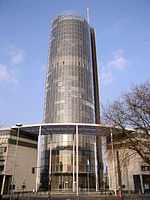The Central Electricity Generating Board (CEGB) was responsible for electricity generation, transmission and bulk sales in England and Wales from 1958 until privatisation of the electricity industry in the 1990s.

E.ON SE is a European electric utility company based in Essen, Germany. It runs one of the world's largest investor-owned electric utility service providers. The name comes from the Latin word aeon, from the Greek aion which means age. The company is a component of the Euro Stoxx 50 stock market index, DAX stock index and a member of the Dow Jones Global Titans 50 index.
RWE AG is a German multinational energy company headquartered in Essen. It generates and trades electricity in Asia-Pacific, Europe and the United States. The company is the world's number two in offshore wind power and Europe's third largest in renewable energy. In the 2020 Forbes Global 2000, RWE Group was ranked as the 297th -largest public company in the world.
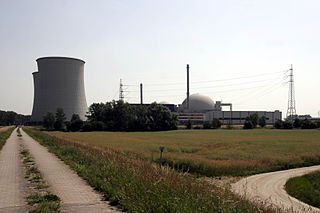
The Biblis Nuclear Power Plant is in the South Hessian municipality of Biblis and consists of two units: unit A with a gross output of 1200 megawatts and unit B with a gross output of 1300 megawatts. Both units are pressurized water reactors. The operator of this power plant is the German RWE Power AG, an electrical utility based in Essen. Unit A began operation on July 16, 1974 and entered commercial service on August 25, 1974; unit B reached criticality on March 25, 1976. Both units now are shut down definitely for political reasons (Atomausstieg).

The Nuclear Power Plant in Cernavodă is the only nuclear power plant in Romania. It produces around 20% of the country's electricity. It uses CANDU reactor technology from AECL, using heavy water produced at Drobeta-Turnu Severin as its neutron moderator and as its coolant agent. The Danube water is not used for cooling of the active zone.
The Urenco Group is a British-German-Dutch nuclear fuel consortium operating several uranium enrichment plants in Germany, the Netherlands, United States, and United Kingdom. It supplies nuclear power stations in about 15 countries, and states that it had a 29% share of the global market for enrichment services in 2011. Urenco uses centrifuge enrichment technology.

Scholven Power Station is a coal-fired power plant in Gelsenkirchen, Germany. With an installed capacity of 2,126 megawatts, it is one of the largest power stations in Europe. It is owned by Uniper.

Niederaussem Power Station is a lignite-fired power station in the Bergheim Niederaussem/Rhein Erft circle, owned by RWE. It consists of nine units, which were built between 1963 and 2003. It is the second-largest lignite coal power plant in operation in Germany, with total output capacity of 3,864 MW and a net capacity of 3,396 MW. The plant is estimated to have been one of the ten most carbon polluting coal-fired power plants in the world in 2018, at 27.2 million tons of carbon dioxide, and its emissions intensity is estimated to be 45.1% higher relative to the average for all fossil-fueled plants in Germany. According to the study Dirty Thirty, issued in 2007 by the WWF, Niederaussem Power Station is the second worst power station in Europe in terms of mercury emissions due to the use of lignite.

Nuclear power in Germany accounted for 13.3% of German electricity supply in 2021, generated by six power plants, of which three were switched off at the end of 2021, the other three due to cease operation at the end of 2022 according to the complete nuclear phase-out plan of 2011. However, in early 2022 this plan was called into question once more in light of the 2022 Russian invasion of Ukraine which threatens Germany's supply of natural gas. There have been calls to either delay the shutdown of the remaining three reactors or to restart operation in those reactors that were shut down in late 2021.

Oldbury nuclear power station is a Magnox nuclear power station undergoing decommissioning. It is located on the south bank of the River Severn close to the village of Oldbury-on-Severn in South Gloucestershire, England. The ongoing decommissioning process is managed by Magnox Ltd, a subsidiary of the Nuclear Decommissioning Authority (NDA).

Emsland Nuclear Power Station is a nuclear reactor located in the district of Emsland, Germany just south of the Lingen Nuclear Power Plant. The reactor has 193 fuel elements totaling a core weight of 103 tons. It is a Konvoi type reactor.
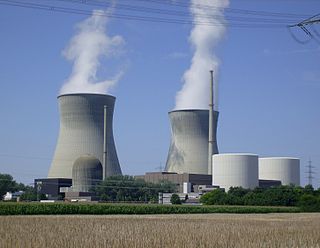
The Gundremmingen Nuclear Power Plant is a nuclear power station in Germany. It is located in Gundremmingen, district of Günzburg, Bavaria. It is operated by Kernkraftwerk Gundremmingen GmbH, a joint operation of RWE Power AG (75%) and PreussenElektra (25%). Unit B was shut down at the end of 2017. Unit C, the last boiling water reactor in Germany, was shut down on New Year's Eve 2021, as part of the German nuclear phase out. However, Gundremmingen unit C as well as the other two German nuclear reactors shut down that day remain capable of restarting operations as of March 2022. In November 1975, Unit A was the site of the first fatal accident in a nuclear power plant and subsequently of a major incident resulting in a total loss in 1977.

The nuclear power station Mülheim-Kärlich lies on the Rhine, about 10 km northwest from Koblenz, close to the town Mülheim-Kärlich in Germany. The operating company was Société Luxembourgeoise de Centrales Nucléaires, a daughter company of RWE. It was the only nuclear power plant in the Rhineland-Palatinate after it was finished in 1986, however, due to problems with the building permit it only operated for 3 years and was taken offline in 1988. Subsequent attempts to bring the plant online continued until 1998 when the supreme court ruled for it to never be restarted.
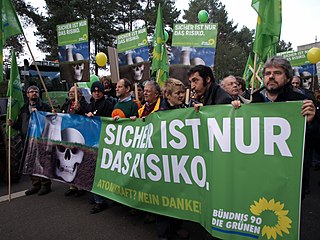
The anti-nuclear movement in Germany has a long history dating back to the early 1970s when large demonstrations prevented the construction of a nuclear plant at Wyhl. The Wyhl protests were an example of a local community challenging the nuclear industry through a strategy of direct action and civil disobedience. Police were accused of using unnecessarily violent means. Anti-nuclear success at Wyhl inspired nuclear opposition throughout Germany, in other parts of Europe, and in North America. A few years later protests raised against the NATO Double-Track Decision in Germany and were followed by the foundation of the Green party.
Romania currently has 1,400 MW of nuclear power capacity by means of one active nuclear power plant with 2 reactors, which constitutes around 18% of the national power generation capacity of the country. This makes Romania the 24th largest user of nuclear power in the world.

Neurath Power Station is a lignite-fired power station at Neurath in Grevenbroich, North Rhine-Westphalia, Germany. It is located to the south of Grevenbroich, and it borders the municipalities of Rommerskirchen and Bedburg. The power station consists of seven units and it is owned by RWE. It was named as the second biggest single polluter for carbon dioxide emissions in the European Union in 2019 by the EU's Transport and Environment Group.

Horizon Nuclear Power is a British energy company that was expected to build new nuclear power stations in the United Kingdom. It was established in 2009, with its head office in Gloucester, and is now owned by Hitachi.
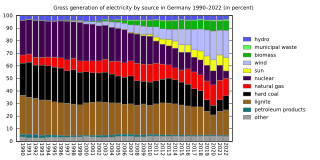
Germany's electrical grid is part of the Synchronous grid of Continental Europe. In 2020, due to COVID-19 conditions and strong winds, Germany produced 484 TW⋅h of electricity of which over 50% was from renewable energy sources, 24% from coal, and 12% from natural gas. This is the first year renewables represented more than 50% of the total electricity production and a major change from 2018, when a full 38% was from coal, only 40% was from renewable energy sources, and 8% was from natural gas.

PreussenElektra GmbH is a subsidiary of the German utility E.ON. It is responsible for operation and decommissioning of the E.ON's nuclear assets.

















